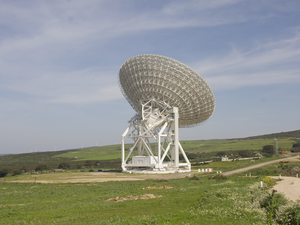Project
Introduction

The Sardinia Radio Telescope (SRT, Lat. 39.4930N - Long. 9.2451E) is a 64-meter single-dish radio telescope with state-of-the-art technological capabilities.
The SRT is a versatile instrument for radio astronomy, geodynamical studies and space science, which can be operated in either single dish or Very Long Baseline Interferometry (VLBI) mode. Its strengths include a large collecting area (a steerable parabolic dish with 64 meters of diameter) combined with state-of-the-art technology, allowing for a high efficiency up to 115 GHz. The optical system is based on a quasi-Gregorian dish antenna with mirrors that are shaped to minimize the standing wave that bounces between the two reflectors. Three additional mirrors, combined in a Beam Wave Guide (BWG) configuration, increase the number of focal positions.
In 2003, the German company MTM® was commissioned with manufacturing the SRT's mechanical parts and then with their on-site assembly. The construction of the telescope was completed in August 2012. The technical commissioning phase, managed by the National Institute for Astrophysics (INAF), began in early 2012 and concluded in 2014. The astronomical validation team then performed scientific commissioning activities, thereby transforming a powerful technological instrument into a world-class radio astronomical facility. During the commissioning activities, Target of Opportunity observations also delivered promising results, such as the 2013 detection of radio pulses at 7 GHz from the Magnetar PSR J1745-2900.
After the technical and scientific commissioning activities ended, an early science program was offered from February through July 2016 and delivered outstanding scientific results. Scientific observations were then stopped to enable the refurbishing of the antenna's surface. A new call for proposals is now planned for September 14, 2018. Details on how to submit proposals are provided here:
